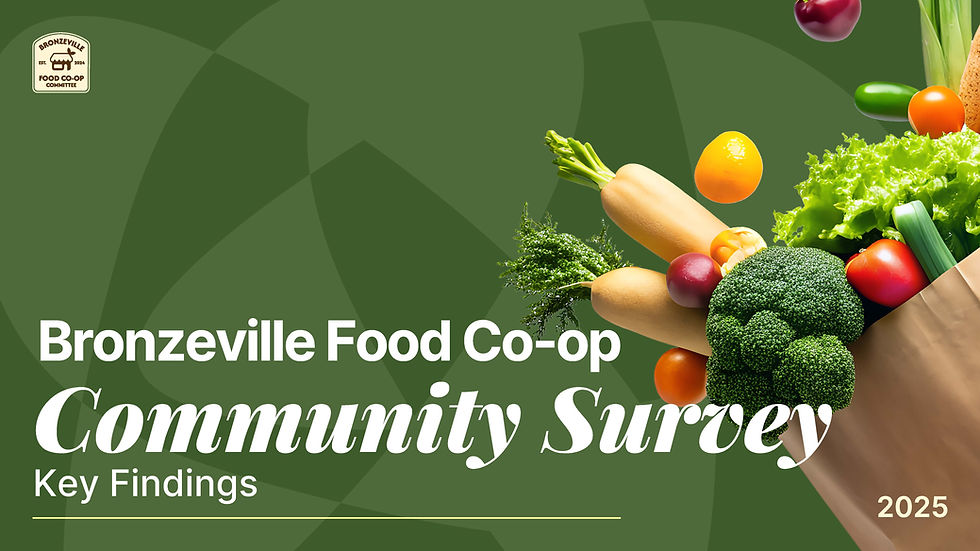The Bronzeville Food Co-op Origin Story
- mrshortscreates

- Aug 14
- 3 min read
Updated: Aug 22

For over two decades, the Bronzeville community has been eager to bring back a neighborhood grocery store - ever since Carl Brown’s Foodliner and Singletary’s Supermarket closed their doors closed its doors, leaving a gap not just in access to food and supplies, but in community connection. While other development projects have brought retail and restaurants to the Near East Side, none focused on reestablishing a grocery store - until a convergence of efforts in the summer of 2023.
That summer, a growing movement took shape as residents, local churches, neighborhood associations, community gardens, and development groups came together to explore the possibilities. At the same time, researchers at Columbus Public Health were examining the legacy of redlining and identified the Near East Side as one of the city’s largest “food deserts,” using both grocery store proximity and social vulnerability index data (Map, Figure 1).
Grocery Stores with Half-Mile Radius Buffers and Social Vulnerability (2020)

In 2022, Columbus Public Health epidemiologists mapped grocery store presence over SVI (Social Vulnerability index) refers to the socioeconomic factors (such as poverty, lack of access to transportation, and crowded housing) that adversely affect communities that encounter community-level stressors. The Near East Side was the largest “food desert i the City of Columbus.
After a powerful community conversation on food justice hosted by Broad Street Presbyterian Church, the Bronzeville Food Co-op Committee was born. What began as the Near East Side Food Access Co-op Committee quickly grew into a monthly gathering of residents, institutions, and organizations committed to launching a community-owned grocery store in Bronzeville. Today, 15 active Steering Committee members continue this work together.
Reviving Bronzeville’s Legacy
New Food Co-op Aims to Reconnect Community with Its Historic Roots
Once hailed as the “Million Dollar Mile,” Bronzeville’s Mount Vernon Avenue was a bustling hub of Black-owned businesses throughout the early to mid-20th century. This corridor thrived with grocery stores, pharmacies, entertainment venues, and entrepreneurial spirit, forming the economic backbone of the community. Despite setbacks in the 1960s, including urban renewal projects and the construction of Interstate 71 that displaced residents and fragmented neighborhoods, the heart of Bronzeville has never stopped beating.
Today, that heartbeat grows stronger with a bold new initiative: the Bronzeville Food Co-op, a collaborative effort involving local stakeholders, residents, and community partners to re-establish a full-service grocery store owned and operated by the people it serves.
This new cooperative model seeks to carry forward the legacy of pioneers like Carl L. Brown Sr., who turned a modest fruit and vegetable stand into the Carl Brown Fruit Market in 1941. His expansion into the IGA Foodliner at 1315 Mt. Vernon Avenue in 1969 - backed by one of the largest loans ever given to an African American entrepreneur in Columbus at the time - transformed his business into a cornerstone of the neighborhood for decades.

Although past efforts such as Singletary’s Supermarket (Plaza Mart) at the corner of Miami and Mt. Vernon Avenues were short-lived, they reflected a continuous drive toward community empowerment through access to fresh food.

The new Bronzeville Food Co-op builds on this tradition, aiming to provide healthy, locally sourced products while addressing the persistent issues of food insecurity and disinvestment. It complements existing initiatives like the Bronzeville Growers Market, held weekly from July to September at 925 Mt. Vernon Avenue, where local farmers and artisans connect directly with residents.
Alongside community gardens and urban farming programs, the Co-op represents more than just a place to shop, it’s a vehicle for economic self-determination, cultural preservation, and neighborhood revitalization. In Bronzeville, food is more than nourishment - it’s a legacy, and the co-op is where that legacy continues to grow.


Visit the www.kroger.com/feedback survey website to submit feedback about your in-store experience. The survey helps Kroger to improve customer service, store conditions, and overall shopping experiences. The Krogercomfeedbacks, an official online platform where customers can share their shopping experiences whether it is positive feedback or negative feedback. By participating, customers help stores to enhance its services and products in return, receive rewards.